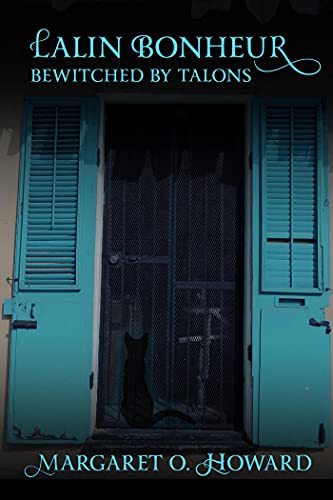Margaret O. Howard. Apalachee Press: Tallahassee, FL, 2021.
In Lalin Bonheur: Bewitched by Talons there is powerful magic and big trouble in the French Quarter of nineteenth century New Orleans. Shapeshifters, werewolves, a witch, prophetic dreams, and ancient African gods in the Old South haunt these pages.
South Louisiana is the setting for Margaret O. Howard’s second novel in the Lalin Bonheur series. Lalin Bonheur, practitioner of Voudoun and healer, faces enemies old and new as she seeks to protect the people she loves and to guard her own life from powerful creatures who will steal her magic.
The story opens with the delivery of a note, pushed through the slats of Lalin’s door, warning of danger and asking for a meeting. When Lalin meets with the note’s author, she is told that loup garou—werewolves—are establishing themselves in New Orleans with the intention of taking “control of all the mystic powers in the city.” Lalin, the most powerful healer and priestess, and with the largest following among the black and creole peoples of the city and surrounding bayous, is at the top of their hit list.
Assisted by her lover and protector Etienne, Lalin stalks the loup garou in the shape of a small black and white cat, attempting to discover when, where and how the werewolves will strike. At the same time, she must also defend Etienne from her rival, a marriage-minded shape-shifting witch. Lastly, can she trust the mysterious Frenchman who claims to be visiting New Orleans to study the folk medicine of the black and creole peoples? She has seen him in a vision, yes, and her parish priest vouches for him. However, he appears to be chiefly interested in plants with a reputation for dangerousness, particularly wolfsbane.
Lalin Bonheur: Bewitched by Talons reads like the waters of a bayou, where mystery and danger are concealed by a placid surface. Lalin, as a character, is soft-spoken and yet wholly confident in her skills and powers. Her first person voice is refined and old-fashioned, as suits the period, and the cadences with which the novel’s characters speak has a lulling effect—out of which danger and violence can erupt at any time.
Howard’s love for the city and her research into this particular historical time is clear. Her writing recreates mood and location: market, street, and forest, the weather and the rhythms of daily living. Suspense ebbs and flows, each ebb of domesticity, which is important to Lalin, followed by a higher upsurge of danger. When full horror breaks through, it is all the more gripping.
Lalin Bonheur: Bewitched by Talons is an excellent tale for a reader who appreciates a gothic atmosphere and a touch of horror but without carnage and gore. It does not strive to take the reader on a rollercoaster ride with witches screaming into the lightning, monsters lurking and leaping, titanic battles between massed forces of Good and Evil, and the rest of the usual paraphernalia of fantasy horror. Instead, there is Lalin, tipping through the shadows of New Orleans in her small black and white cat skin. A reader wants to tip with her, to see where the story goes.
–Melanie A. Rawls

